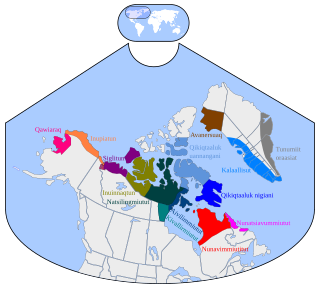
Back Inuinnaqtun Catalan Inuinnaqtun German Inuinaktuna lingvo Esperanto Inuinnaqtun Spanish Inuinnaqtun Estonian Inuinnaqtun Basque Inuinnaqtun French Inuinnaqtun FRR Inuinnaqtun GV Inuinnaqtun HIF
| Inuinnaqtun | |
|---|---|
| ᐃᓄᐃᓐᓇᖅᑐᓐ | |
| Pronunciation | [inuinːɑqtun] |
| Native to | Canada (Nunavut and Northwest Territories) |
Native speakers | 1,310 (2016 census)[1] |
Eskaleut
| |
Early forms | |
| Official status | |
Official language in | Nunavut[2] Northwest Territories[3] |
| Regulated by | Inuit Tapiriit Kanatami[citation needed] |
| Language codes | |
| ISO 639-1 | iu |
| ISO 639-2 | iku Inuktitut |
| ISO 639-3 | ikt Inuinnaqtun, Western Canadian Inuktitut |
| Glottolog | copp1244 |
 Inuit dialects. Inuinnaqtun is olive green. | |
 Inuinnaqtun is classified as Definitely Endangered by the UNESCO Atlas of the World's Languages in Danger | |
| Inu- ᐃᓄ- / nuna ᓄᓇ "person" / "land" | |
|---|---|
| Person | Inuinnaq |
| People | Inuinnait |
| Language | Inuinnaqtun; Tikuraq ᑎᑯᕋᖅ |
| Country | Inuinnait Nunangat, Inuit Nunangat ᐃᓄᐃᑦ ᓄᓇᖓᑦ |
Inuinnaqtun (Inuinnaqtun: ᐃᓄᐃᓐᓇᖅᑐᓐ, IPA: [inuinːɑqtun]; natively meaning 'like the real human beings/peoples') is an Inuit language. It is spoken in the central Canadian Arctic. It is related very closely to Inuktitut, and some scholars, such as Richard Condon, believe that Inuinnaqtun is more appropriately classified as a dialect of Inuktitut.[4] The government of Nunavut recognises Inuinnaqtun as an official language in addition to Inuktitut, and together sometimes referred to as Inuktut.[2][5] It is spoken in the Northwest Territories as well and is recognised as an official language of the territory in addition to Inuvialuktun and Inuktitut.[3]
Inuinnaqtun is used primarily in the communities of Cambridge Bay, Kugluktuk and Gjoa Haven in the Kitikmeot Region of Nunavut. Outside Nunavut, it is spoken in the hamlet of Ulukhaktok, Northwest Territories,[6] where it is also known as Kangiryuarmiutun, forming a part of Inuvialuktun.[7] It is written using the Roman orthography[8] except in Gjoa Haven, where Inuit syllabics are used (as for Natsilingmiutut).
- ^ "Census in Brief: The Aboriginal languages of First Nations people, Métis and Inuit". www12.statcan.gc.ca. 25 October 2017. Retrieved 2017-11-12.
- ^ a b Official Languages Act, S.Nu. 2008, c. 10, s. 3(1) with Inuit Language Protection Act, S.Nu. 2008, c. 17, s. 1(2).
- ^ a b Official Languages Act, RSNWT 1988, c. O-1, s. 4 in its 2003 version; PWNHC: Official Languages of the Northwest Territories Archived 2021-10-19 at the Wayback Machine
- ^ Condon, Richard; Julia Ogina; The Holman Elders (1996). "Foreword". The Northern Copper Inuit. University of Toronto Press/University of Oklahoma Press. p. xix. ISBN 0-8020-0849-6. Retrieved 2011-02-09.
...the majority of Holman residents speak the central Arctic dialect, Inuinnaqtun...
- ^ "We Speak Inuktut". Archived from the original on 2023-08-16. Retrieved 2021-02-27.
- ^ "Let's Speak Inuinnaqtun - About Us". Retrieved 2021-02-27.
- ^ Inuvialuit Cultural Centre: Inuvialuit Digital Library – Language Resources
- ^ CBC Original Voices: Inuinnaqtun